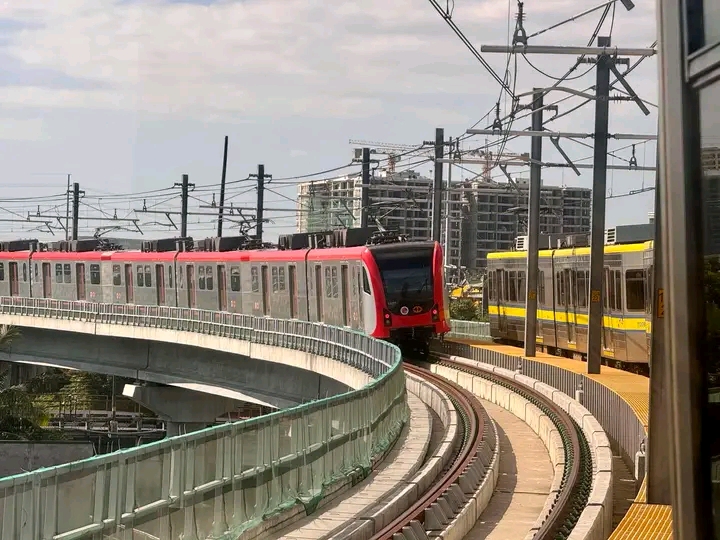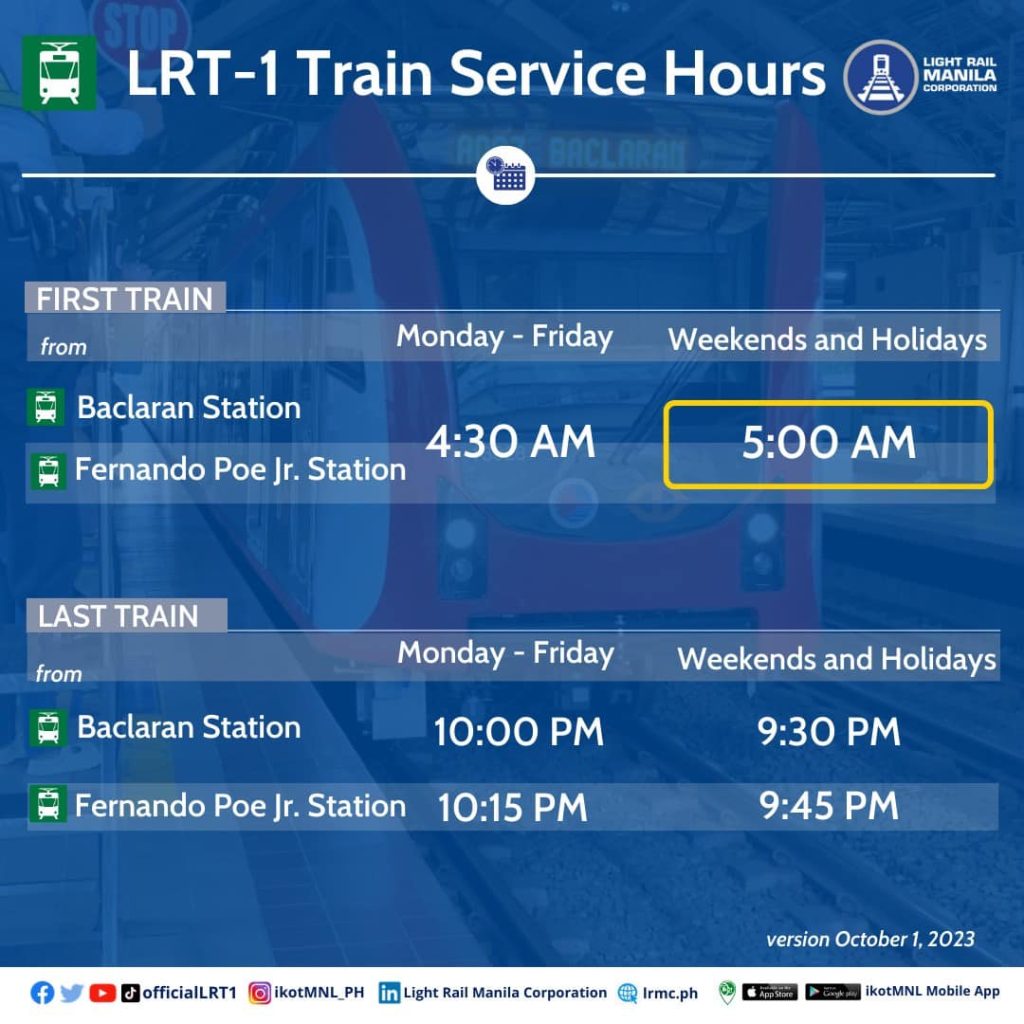The Manila Light Rail Transit System Line 1 (LRT-1), established by Marcos in 1980 and operational since December 1984, is a crucial component of Manila’s transportation infrastructure, offering quick and convenient travel options. As the earliest light rail system in the Philippines and the second in Asia, it is commonly referred to as the Green Line. Spanning twenty stations across Metro Manila, LRT-1 is operated by the Light Rail Manila Corporation (LRMC), and provides connectivity to those who need to traverse these four cities in the metro: Pasay, Manila, Caloocan, and Quezon City.
Since its inauguration in 1984, LRT-1 has been a pioneer in Southeast Asia’s light rail transit systems, providing commuters with a convenient means of travel across the urban landscape. It continuously offers a welcome relief to commuters who are seeking to reduce travel time and escape Manila’s notorious traffic and heat. Currently, only two LRT lines are operational, with LRT-1 being one of them, but future plans include expanding the line and adding more train wagons to meet the needs of the nearly 800,000 daily riders.
LRT-1 Stations List in Order
Commuting in the National Capital Region (NCR) can be exhausting due to traffic congestion and intense heat. However, the LRT-1, a 15-kilometer elevated railway system with twenty strategically situated stations spanning four cities, serves over 275,000 passengers daily, providing a dependable, effective, and faster transportation solution in the region. Since its inception, the system has undergone several upgrades to improve service and extend its reach.

Now, let’s explore this list of LRT-1 stations from south to north, along with the prominent destinations and notable landmarks and features accessible at each stop.
Baclaran Station
Location: Pasay City
Notable Landmarks: Baclaran Church, Ninoy Aquino International Airport (NAIA), SM Mall of Asia
Features: Southernmost station, major hub for northbound commuters.
Situated at the southernmost tip of LRT-1, Baclaran Station serves as a bustling hub for commuters traveling northward. Adjacent to vibrant markets and shopping centers, this station offers easy access to key landmarks such as the Ninoy Aquino International Airport (NAIA) and SM Mall of Asia.
EDSA Station
Location: Pasay City
Notable Landmarks: EDSA, Metropoint Mall, major bus terminals
Features: Key transfer point, access to bus routes and shopping centers.
Named after the iconic thoroughfare it intersects, EDSA Station serves as a crucial transfer point for commuters traversing northbound routes. With proximity to major bus terminals and shopping complexes like SM Mall of Asia, this station ensures seamless connectivity across Metro Manila.
Libertad Station
Location: Pasay City
Notable Landmarks: Cartimar Shopping Center, Pasay City Hall
Features: Also known as Arnaiz Station, close to markets and commercial areas.
Also known as Arnaiz Station, Libertad Station caters to passengers commuting within Pasay City. With its strategic location near diplomatic offices and commercial establishments, this station is a bustling transit point for locals and tourists alike.
Gil Puyat Station
Location: Pasay City
Notable Landmarks: World Trade Center, Buendia Avenue
Features: Gateway to business districts and cultural sites.
Positioned at the heart of Makati, Gil Puyat Station serves as a gateway to the city’s vibrant business district and cultural landmarks. From the World Trade Center to SM Mall of Asia, this station offers convenient access to various destinations within Metro Manila.
Vito Cruz Station
Location: Manila
Notable Landmarks: De La Salle University, Cultural Center of the Philippines
Features: Serves students and tourists, access to educational institutions.
Nestled amidst educational institutions and cultural landmarks, Vito Cruz Station caters primarily to students and tourists exploring Manila’s vibrant arts and heritage scene. With its proximity to De La Salle University and the Cultural Center of the Philippines, this station is a gateway to enriching experiences.
Quirino Station
Location: Manila
Notable Landmarks: Manila Zoo, Manila Baywalk
Features: Situated in Malate, close to leisure and historical sites.
Serving the historic district of Malate, Quirino Station offers convenient access to Manila’s iconic landmarks and leisure destinations. From Manila Zoo to Manila Baywalk, this station invites travelers to explore the city’s cultural heritage and natural beauty.
Pedro Gil Station
Location: Manila
Notable Landmarks: Robinsons Place Manila, University of the Philippines Manila
Features: Commercial district, educational institutions nearby.
Located within Manila’s bustling commercial district of Ermita, Pedro Gil Station offers a gateway to vibrant shopping centers and educational institutions. Whether you’re visiting Robinsons Place Manila or University of the Philippines Manila, this station ensures seamless connectivity for commuters.
UN Avenue Station
Location: Manila
Notable Landmarks: Supreme Court of the Philippines, National Museum
Features: Proximity to government offices and cultural landmarks.
Positioned in close proximity to government offices like the National Bureau of Investigation (NBI) and cultural institutions, UN Avenue Station serves as a vital transit point for commuters exploring Manila’s historic landmarks and scenic attractions.
Central Terminal Station
Location: Manila
Notable Landmarks: Intramuros, Rizal Park
Features: Central hub for historical and cultural explorations.
Serving as a gateway to Old Manila’s rich heritage and cultural landmarks, Central Terminal Station offers convenient access to iconic sites such as Intramuros and Rizal Park. With its proximity to educational institutions and museums, this station is a hub for learning and exploration.
Carriedo Station
Location: Manila
Notable Landmarks: Quiapo Church, Binondo Chinatown
Features: Bustling market areas, rich cultural heritage.
Located amidst bustling market districts and historical landmarks, Carriedo Station offers a glimpse into Manila’s vibrant street life and cultural heritage. From Binondo to Quiapo, this station invites travelers to immerse themselves in the city’s bustling markets and religious sites.
Doroteo Jose Station
Location: Manila
Notable Landmarks: University of the East, Far Eastern University
Features: Strategic transfer point, educational institutions nearby.
Named after a local hero, Doroteo Jose Station serves as a vital transit point for commuters traveling between Manila’s bustling districts. With its strategic location near universities and shopping centers, this station, otherwise known as the Recto Station, ensures seamless connectivity for passengers.
Bambang Station
Location: Manila
Notable Landmarks: Jose Reyes Memorial Medical Center, University of Santo Tomas
Features: Medical and educational hub.
Nestled amidst medical institutions and educational hubs, Bambang Station caters primarily to students and healthcare professionals. Whether you’re visiting University of Santo Tomas or Jose Reyes Memorial Medical Center, this station offers convenient access to key destinations.
Tayuman Station
Location: Manila
Notable Landmarks: SM City San Lazaro, Dangwa Flower Market
Features: Access to shopping centers and markets.
Serving as a gateway to Manila’s vibrant districts, Tayuman Station offers convenient access to shopping centers and cultural landmarks. Whether you’re exploring Dangwa Flower Market or SM City San Lazaro, this station ensures seamless connectivity for travelers.
Blumentritt Station
Location: Manila
Notable Landmarks: Blumentritt Market, Chinese General Hospital
Features: Vital transit point for various districts.
Serving as a vital transit point for commuters traveling between Manila’s diverse districts, Blumentritt Station offers convenient access to shopping centers and cultural landmarks. Whether you’re exploring Santa Cruz or Tondo, this station invites travelers to experience Manila’s vibrant street life and heritage.
Abad Santos Station
Location: Manila
Notable Landmarks: Gagalangin, Felipe G. Calderon Elementary School
Features: Residential and commercial area.
Located amidst bustling residential neighborhoods and commercial centers, Abad Santos Station offers convenient access to key destinations within Tondo and Santa Cruz. Whether you’re visiting local markets or medical institutions, this station ensures seamless connectivity for commuters.
R. Papa Station
Location: Manila
Notable Landmarks: La Loma Cemetery, Marulas Elementary School
Features: Crossroads of bustling districts.
Positioned at the crossroads of Manila’s bustling districts, R. Papa Station offers convenient access to residential neighborhoods and cultural landmarks. Whether you’re exploring La Loma Cemetery or Marulas Elementary School, this station invites travelers to experience Manila’s diverse communities.
5th Avenue Station
Location: Caloocan City
Notable Landmarks: Thai To Taoist Temple, Northern Rizal Yorkin Chinese School
Features: Gateway to Caloocan’s vibrant districts.
Serving as a gateway to Caloocan’s vibrant districts, 5th Avenue Station offers convenient access to shopping centers and educational institutions. Whether you’re visiting Thai To Taoist Temple Pagoda or Northern Rizal Yorkin Chinese School, this station ensures seamless connectivity for commuters.
Monumento Station
Location: Caloocan City
Notable Landmarks: Bonifacio Monument, SM City Grand Central
Features: Major commercial center, historical landmarks.
Nestled amidst bustling commercial centers and historical landmarks, Monumento Station offers convenient access to key destinations within Caloocan and neighboring cities. Whether you’re exploring Monumento Circle or SM City Grand Central, this station invites travelers to experience Caloocan’s rich heritage and vibrant street life.
Balintawak Station
Location: Quezon City
Notable Landmarks: Ayala Malls Cloverleaf, Landers Superstore
Features: Key northern station, access to residential and shopping areas.
Serving as a gateway to Quezon City’s bustling districts, Balintawak Station offers convenient access to shopping centers and residential neighborhoods. Whether you’re exploring Ayala Malls Cloverleaf or Landers Superstore, this station ensures seamless connectivity for commuters.
Fernando Poe Jr. Station
Location: Quezon City
Notable Landmarks: Veterans Memorial Medical Center, Munoz Market
Features: Northern terminus, previously known as Roosevelt Station.
Formerly known as Roosevelt Station, Fernando Poe Jr. Station serves as the northern terminus of the LRT-1. With its proximity to major landmarks and transportation hubs, this station offers convenient access to key destinations within Quezon City and beyond.
Additional LRT-1 Stations
The LRT-1 network is expected to expand through the Cavite Extension Project, adding eight new stations into the roster of stations. These include:
- Redemptorist
- MIA
- Asia World
- Ninoy Aquino
- Dr. Santos
- Las Piñas
- Zapote, and
- Niog
This extension will enhance connectivity for commuters traveling between Cavite and Metro Manila, improving accessibility and reducing travel time.
Schedule
The LRT-1 trains operate under the following schedule:

First Train
- From Baclaran – 4:30 a.m. (weekdays)
- From FPJ – 5:00 a.m. (weekends and holidays)
Last Train
- From Baclaran – 10:00 p.m. (weekdays) / 9:30 p.m. (weekends and holidays)
- From FPJ – 10:15 p.m. (weekdays) / 9:45 p.m. (weekends and holidays)
Payment
Payments for LRT-1 services can be made at the following:
- LRT teller booths
- LRT teller machines
The payment method can be either via:
- Single-use journey cards
- Beep™ cards
- Stored value cards
Dos and Don’ts When on the LRT-1 Stations
For safety and convenience, commuters are expected to observe the following dos and don’ts:
- Do not eat, drink, or smoke within the stations.
- Hold onto safety handrails during transit.
- Do not lean against train doors.
- Be mindful of surroundings to safeguard belongings.
- Avoid touching emergency devices unnecessarily.
Video: LRT-1 Train Ride (Baclaran to Central Station)
For a visual guide to the LRT-1 stations from Baclaran to Central Station and their surroundings, check out this informative video from Ang Litratista ng Daang Bakal. It offers a closer look at the features and landmarks of each station, helping you navigate this transport system with ease. Whether you’re a daily commuter or a first-time visitor, this video will provide valuable insights into the LRT-1 experience.
Summary
Despite the challenges posed by high demand and crowded trains, the LRT-1 remains an indispensable part of Manila’s public transportation network, serving numerous passengers daily across its extensive network of stations. Future expansions and upgrades promise to further enhance the efficiency and coverage of the green line, but for now, the government, via the current LRT-1 does offer a reliable service to traverse and observe the wonders of these four cities of the National Capital Region (NCR).